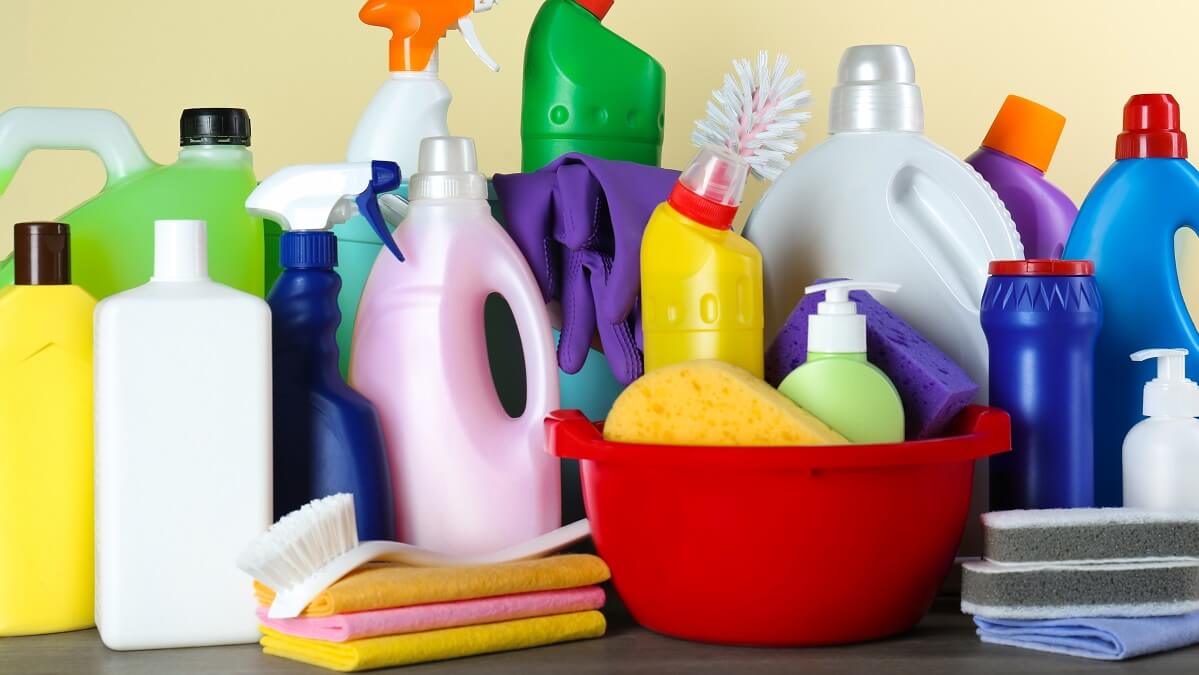You may have seen the trend of social media creators combining a whole bunch of different cleaners in their toilet only to scrub a few times and then flush it all away. Most people know this is over the top, wasteful and downright dangerous if you don’t know what you’re doing, but the videos are somehow very popular.
“Certain cleaning chemicals can be very poisonous when mixed together, and in general cleaning products should never be mixed together because of the risk of unwanted toxic inhalation effects,” says medical toxicologist Dr Kelly Johnson-Arbor.
Furthermore, while many people may think that mixing products makes cleaning faster or more effective, according to Dr Johnson-Arbor, that isn’t necessarily true. The saying about having too much of a good thing definitely applies here.
So, keep it simple and stay safe by never mixing up the seven dangerous cleaning product combinations below.
Toilet bowl cleaner and bleach
Typically, if you’re cleaning it enough and you don’t have particularly hard water, a squirt of toilet bowl cleaner and a quick brush is enough to remove all the surface gunk from the toilet bowl.
There’s no need to add bleach to the mix as this is dangerous. “Combining toilet bowl cleaner and bleach can make chlorine gas,” says Dr Johnson-Arbor. “For healthy people, inhalation of either of these gases can cause coughing, irritation of the nose and throat, and even trouble breathing. For those who have asthma, COPD or other lung diseases, serious respiratory problems can occur after inhalation of these chemicals and can even result in death.”
While this rule might not apply to every toilet bowl cleaner on the market, it’s generally unsafe to mix bleach with anything.
If you are exposed to any of these chemicals and have difficulty breathing, Dr Arbor-Johnson suggests going outside immediately to get fresh air. “If the irritating symptoms persist after 10 to 15 minutes or if you have a history of asthma or other lung diseases, you may need to go to an urgent care centre or emergency room for specialised treatment.”
Bleach and ammonia
One of the most common examples of consumers unintentionally combining things they shouldn’t is bleach and ammonia. Chlorine bleach – found in whitening laundry products, toilet cleaners and some disinfectants – mixed with ammonia, most often found in window cleaners, results in a chemical reaction that creates a toxic fume of chloramine gas. In high enough concentration, this gas can be lethal.
While bleach is a common ingredient in many cleaning products, it may not be as obvious when products contain ammonia. Be sure to read the label carefully and look for products that are advertised as being ammonia free.
Bleach and vinegar
Mixing pure chlorine bleach, or bleach-based products, and white vinegar, cleaning vinegar, or even non-toxic vinegar-based solutions can be hazardous. Mixing bleach with any acid or acidic product such as toilet cleaner can create chlorine gas which can cause coughing, breathing problems, burning and watery eyes.
If you accidentally create chlorine gas, don’t try to water it down. Chlorine gas and water combine to make hydrochloric and hypochlorous acids, which are also irritants.
Instead, remove yourself, your family and any pets from the area, get fresh air, monitor your symptoms and seek medical attention if needed.
Hydrogen peroxide and vinegar
Combining hydrogen peroxide and vinegar creates peracetic acid. This combination isn’t just highly corrosive but also poses a danger to the eyes, skin, throat, nose and even the lungs.
Drain cleaner and bleach
Drain cleaners by themselves contain very dangerous chemicals that can be harmful to your health if you swallow them, breathe them in or if they come in contact with your skin and eyes.
You might think that pouring bleach in after using drain cleaner will neutralise odours but Carol Mehas, founder of eco-friendly cleaning brand Arbour, warns that this can be incredibly dangerous.
“It’s a recipe for a lethal reaction to take place in a very small pipe. Drain cleaners are usually made with lye, also known as sodium hydroxide, to chemically break apart build up and caustic potash to speed the destruction of organic matter – the yucky hair and soap scum lining your drain,” she says. “Since your drain is a small, confined space, the noxious gasses that form from the chemical reactions taking place have nowhere to go but straight up the drain, back into your shower.”
If this combination is inhaled, it can burn your mouth and throat or potentially cause lung damage.
Different brands of drain cleaners
Clogged drains are frustrating, and if Drano doesn’t work the first time, you might be tempted to try another brand. However, due to some drain cleaners being alkaline-based and others acid-based, combining them can cause the release of chlorine gas, or worse, an explosion.
So, either stick to the one product or call in a professional for help.
Bleach and rubbing alcohol
Bleach and rubbing alcohol or isopropyl alcohol create chloroform. This combination is highly toxic and can cause damage to your eyes, lungs and liver. Combining these products can create peracetic/peroxyacetic acid, which can be highly corrosive and irritating.
Keep in mind that some popular cleaning products, such as disinfectant wipes, contain alcohol and shouldn’t be used with bleach.
Do you stick to certain cleaning brands or try whatever is on special? Let us know in the comments section below.


And do not accidentally drop beads of caustic soda on your wooden floors!!!
I use minimal cleaners as I have asthma. I do have basic bought products, as my Home Care Provider sends a cleaner, and they use these. For myself, as my ancient drains don’t work well, I use baking soda mixed with vinegar, washed down by boiling water. After reading this article, I hope this is safe!